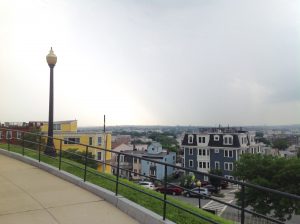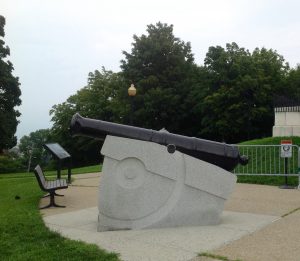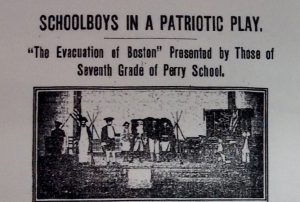On my way to Boston’s Logan Airport a while ago a taxi driver pointed towards Boston Harbor and started telling me about a Revolutionary War monument located behind South Boston High School. As an Irish-American transplant from Chicago, green-colored Red Sox hats and the reputation of the South Boston Irish are very real manifestations of a deep, deep pride in Irish heritage and enduring cultural strength. The memorial sounded curious enough, but it would also be good to look into the iconic culture of mythical South Boston. As we were taught,
Boston became the headquarters of the American Revolution largely because the policy of George III threatened her maritime interests. Instead of trading only with the mother country, [Boston] would trade with England’s rivals and drive English ships from colonial commerce.[1]
When I eventually put together the outing to drive over to see the memorial, I was completely amazed. First of all, from South Boston’s relatively flat harborside Day Boulevard it is a steep, San Francisco-style three-city-block incline inland, up and up what has been alternately called Telegraph Hill or Dorchester Heights.
The 1775 capture of Fort Ticonderoga created the opportunity for General Washington to move scarce cannons and armaments from that fort to Boston in order to press the British at this supremely important maritime port. Henry Knox dragged sixty tons of cannon and gunpowder across the snow-covered forests, hills and streams of New England. In early 1776 Washington sent some 3,000 volunteers to secure Dorchester Heights, and Gen. John Thomas mounted the cannons from Fort Ticonderoga to overlook Boston Harbor. From this vantage point the Americans could blast away at British troops and ships. By this operation Washington ended an eleven-month siege and forced the British to evacuate Boston. Washington’s first victory in the Revolutionary War was recorded on March 17, 1776.
The Dorchester Heights Memorial in Thomas Park overlooks all of Boston from what is now South Boston. It is located behind South Boston High School, three city blocks uphill from Dorchester Bay at Telegraph Street and Old Harbor streets. Etched in stone at the base of the final walkway to the top of the hill, the entrance to the National Park Service memorial is inscribed, “Under the leadership of General John Thomas, 3,000 soldiers fortified these heights in March 1776, forcing the evacuation of British troops from Boston.” At another approach to the park is etched, “As the final act of an eleven month siege, the Continental Army occupied these Heights and forced the evacuation of British troops from Boston on March 17, 1776 – General George Washington’s first victory in the American Revolution.”
While today’s modern South Boston is developed with traditional houses, apartments and high rises, the heights themselves still tower over the former battle sites. You can still see how Washington’s control of these heights, and the Fort Ticonderoga cannons, created an obvious and overwhelming threat to the British troops encamped in the city and the British naval vessels moored in Boston Harbor. Commanding the view to the northeast across Boston’s inner harbor, from historic Dorchester Heights you can see deep into Beacon Hill and Fort Point.

To the west we have a clear view of the rolling hills that characterize New England in general and western Massachusetts in particular. You can appreciate what an unbearable slog through the rugged and wintry New England countryside it must have been to bring cannons and war materials to the heights.

Established as a municipal park in 1853, today clear and informative display signs by the National Park Service detail points on a map as the scene would have appeared to Washington and Thomas. They help explain Knox’s mission and what they call his “noble train of artillery.” The park welcomes visitors from around the world as a uniquely Boston Revolutionary War landmark. But furthermore, it reveals an important aspect of how Boston sees itself, almost a quarter of a millennium later.


With ongoing migration to America, beloved New England could be called New Ireland for the strength, influence and cultural leadership of the once-poor immigrant sons and daughters from England’s first colony, Ireland. Irish first came to Boston in the 1600s as indentured servants, among people of many other nationalities. According to the South Boston Historical Society, “As early as 1737, the memory of the beloved patron saint of Ireland was honored by the Charitable Irish Society. Prominent Bostonians of Irish heritage gathered for prayers and breakfast each March 17, and made charitable contributions to the local alms houses.”[2] Washington’s 1776 victory on the day of their patron saint caused a special connection with the event. The next generation of New England patriots ran the first relief efforts to Irish and Scottish famine victims in 1847 – to the chagrin of the Imperial British themselves. The first relief boats left Boston Harbor for Cork, Ireland, on March 17. According to Samuel Eliot Morison, “the Irish famine of 1846–1847 brought the greatest charitable ‘drive’ of this period. Early in 1847 a New England Relief Committee for the famine in Ireland and Scotland was organized at Boston.” Funds and foodstuffs were quickly collected. Relief rations and cash were loaded on board the ships called Jamestown and Macedonia on St. Patrick’s Day itself, the ships were “officered by civilian volunteers”[3] and arrived at Cork Harbor some fifteen days later. It was the beginning of an effort carried on by many Boston volunteer seamen, who understood desperation and want, to ease the burden of the poor. The heroic relief effort by the Boston seamen, in the spirit of General Washington’s volunteers, gave great impetus to manifestations of pride in the Irish community which still pervades all aspects of life in Boston. Britain’s continued neglect of Ireland, her first colony, further fueled what Morison called, “a fighting spirit.” By 1850 the Irish were emerging as the dominant ethic group in Boston.
The confluence of these events since the 1776 has created a celebration of patriotic pride in Washington’s first victory, intertwined because of the date with St. Patrick’s Day. It has become an American Revolutionary War festival with a dual meaning. And in spite of Knox-like wintry weather, parades are organized every March 17 for Evacuation Day / St. Patrick’s Day celebrations in South Boston. Politicians, members of the armed forces, veterans, and various other “keepers of the flame” all vie for a stake in the annual commemoration ceremonies. In order to balance social, spiritual and political uses of the parade, management and organization is shared by groups such as The Allied War Veterans Council and the South Boston Citizens Association. Upwards of 100,000 parade goers line the parade routes each year making Evacuation Day celebrations the largest Revolutionary War commemoration in the country after the 4th of July. Of the 2018 parade, David Falvey, the South Boston Allied War Veterans Council commander once again confirmed how intertwined the two histories remain, stating, “Our parade … isn’t just a parade to celebrate St. Patrick’s Day, but to celebrate Evacuation Day.”[4]


[1]Samuel Eliot Morison, The Maritime History of Massachusetts (Cambridge, MA: The Riverside Press, 1961), 27.
[2]Paul A. Christian, South Boston on Parade(Boston, MA: Loving Boston Press), 2016.
[3]Morison,The Maritime History of Massachusetts, 242 – 243.







Recent Articles
Joseph Warren, Sally Edwards, and Mercy Scollay: What is the True Story?
This Week on Dispatches: David Price on Abolitionist Lemuel Haynes
The 1779 Invasion of Iroquoia: Scorched Earth as Described by Continental Soldiers
Recent Comments
"Contributor Question: Stolen or..."
Elias Boudinot Manuscript: Good news! The John Carter Brown Library at Brown...
"The 1779 Invasion of..."
The new article by Victor DiSanto, "The 1779 Invasion of Iroquoia: Scorched...
"Quotes About or By..."
This well researched article of selected quotes underscores the importance of Indian...